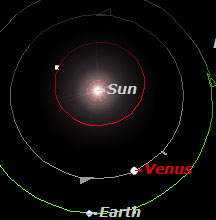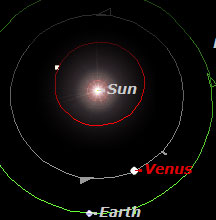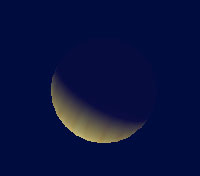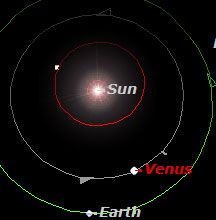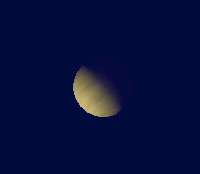View the brilliant “Morning Star” all winter long!
Posted On December 4, 2002
The above graphic shows the position of Venus in the sky over the next few months at 6am every morning. Notice how it is rising in the sky every day until around the end of December. This all corresponds to the orbit of Venus and how it is currently racing away from us and eventually how it loops back around the far side of the Sun. See the full explanation of this below.
The Surprising and Puzzling Venus.
If you do not know what it is - seeing the brilliant morning show put on by Venus can be quite surprising, puzzling or even unsettling to some.
Ever since I started getting involved with the OCA and especially attending Outreach events I have been quite surprised at times by the questions that I get asking me what the bright star is over in the west after sunset - or over towards the east very early in the morning.
While most people have heard of the term "the Morning Star" and "the Evening Star" many do not realize this is not referring to a star (or a couple of them even) at all - but that it is in fact Venus.
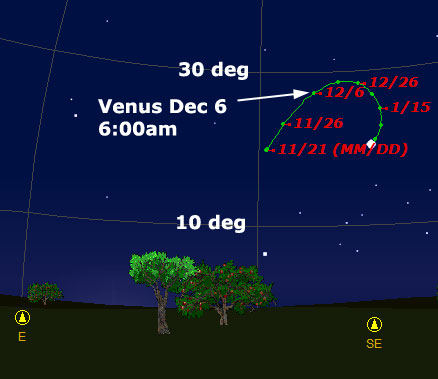
Question from an Irvine Resident
Below is an extract from an email sent to me recently by one very curious Irvine resident:"My question is about something I see in the sky here in Orange County as the sun begins to rise. I've seen this thing every morning for the past couple of months. It appears low in the sky and just to the right of the peak of Saddleback Mountain and is a diagonal slash of white, except once a couple of weeks ago when the sunrise began it took on a glowing red and gold color, then became white as usual. It fades and is no longer visible once the sun is up. Do you know what this is?"This was my reply:
I suspect what you are seeing is the planet Venus.
This is often referred to as "the Morning Star" and also "the Evening Star". In the past few months Venus has switched from being visible in the evening - to being visible in the morning. This is due to it swinging around in front of the Sun as it moves in it's orbit. When it gets closer and closer to us the planet will actually get bigger and bigger and brighter and brighter. If you were to look at it using a telescope you would see it change in phase just like the moon does. At some point it would be more of a slash (line) of white than a round object like you might expect.
The change in color you describe is attributable to atmospheric disturbances due to how close the object is to the horizon (notice that most stars twinkle far more when they are lower/closer to the horizon). I hope that helps.
-Liam
OCA President
What is this "Slash"
The reason someone might see the brilliant Venus as more of a slash than a star can be attributed to perhaps very acute vision and being able to perceive the "star" is in fact more of a crescent disk - although it could also be related to simply how bright it is.
What about the color aberration?
As for that color aberration - one "general" rule often quoted by astronomers about planets is that they very rarely twinkle like stars often do. In fact this is often a very easy test anyone can do to determine if a bright "star" they see in the sky at night is in fact a planet.
Stars twinkle because they are so incredibly distant from us that any disturbances in the atmosphere will bounce around the "ray" of light reaching your eye - effectively making the star twinkle. This is more pronounced the closer the star is to the horizon (more atmosphere to go through).
Planets don't "suffer" from this twinkling anything like stars because, even though they are still very far away, they still are represented in the sky as a definite disk rather than a point source of light. Therefore on average what you will find is that these "multiple" rays of light from the planet (actually just reflected sunlight in fact) manage to cancel out a lot of the atmospheric disturbances.
In the case above Venus was probably so much closer to the horizon - and the atmospheric conditions such that this general rule about non-twinkling planets just didn't hold. Oh well - the exception that proves the rule
So what exactly is happening to Venus to make it appear so bright in the morning sky?
Venus is of course the closest planet to us - it is also covered in clouds. For this reason it reflects the Sun very well making Venus the brightest of all the planets. However throughout the orbit Venus gets progressively closer and then further away from us - and during this time it undergoes a very distinct change is phase and size. The images below illustrate this effect very well.
